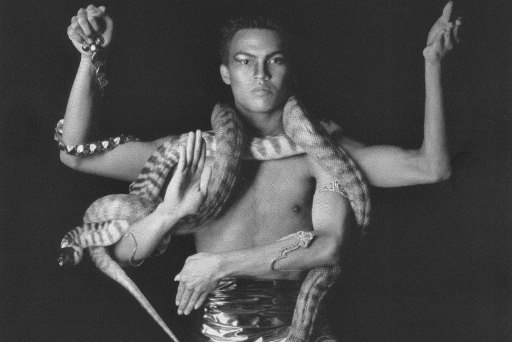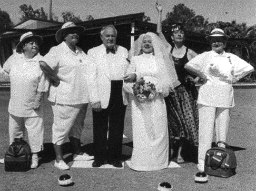Tracks Dance Company is based in Darwin in the Northern Territory, Australia’s only tropical capital city. Place plays a significant part in how, why and what type of work Tracks creates. Cultural influences of the Northern Territory’s Indigenous population, (33% of the total population, against a 3% National average,) and the close proximity to South East Asia, flavour the content of the work, the artists and the communities that the company works with.
The Northern Territory supports a rich diversity of environments from tropical rainforests to arid deserts, with a population of approximately 226,000 people living in an area of 1,347,000 sq km (one-sixth of Australia's land mass, 1% of Australia’s population). The majority of the population lives in the main towns: Darwin (about 125,000), Alice Springs (32,000), Katherine (10,000), Tennant Creek (3,500). Everyone else lives in scattered remote Indigenous communities.
The Territory’s vast deserts have temperatures that can soar to over 45 degrees Celsius by day and plummet to below zero overnight. These regions remain some of the most amazing ecosystems with an abundance of flora and fauna that benefit from a share of the monsoonal rain. These extremes in climate and landscapes produce people with a unique Australian outlook. It is a land of flies and diesel, long corrugated dirt roads, flying doctors, school of the air and harsh landscapes.
Darwin is one of the most cosmopolitan cities in Australia with more than 60 nationalities and 76 ethnic groups represented in the population. Darwin is closer to Singapore and Jakarta than it is to Sydney and Melbourne. Dili, East Timor, is our closest capital city. Darwin harbour is twice the size of Sydney harbour.
The proximity to South East Asia has an appealing effect on Darwin residents. With a tropical climate, locals tend to adopt a different lifestyle to southern Australia. Darwin attracts migration from similar climate countries. Activity in our close neighbours affects our worldview.
There are two major seasons—the Wet and the Dry. The latter guarantees glorious weather and provides perfect conditions for an outdoor lifestyle, leading to our staging of large outdoor performances. The Wet brings monsoonal weather conditions with violent thunderstorms, spectacular lightning displays, and floods.
This unique mix provides the inspiration to create original works about the Territory—its people, place and spirit.
 Erwin Fenis in Snakes, Dogs and Deities. Photo: Mark Marcelis
Erwin Fenis in Snakes, Dogs and Deities. Photo: Mark MarcelisHistory
A 1988 tour to the extremely remote Indigenous community of Lajamanu in the Tanami Desert brought together the creative skills of visual artist Tim Newth and dance artist Sarah Calver. David McMicken joined the mix in 1991 as the Community Dance Officer at Brown’s Mart Community Arts network. Together they forged a uniquely Northern Territorian performing arts company, collaborating with local community and cultural groups. Taking on the name Tracks in 1994, the dance company was born out of the community dance programme.
In 1997 Tracks created a show called 4 Wheel Drive—Sweat Dust and Romance. This extraordinary dance performance drew together professional and community dancers in a show of skill, wit and diversity that celebrated what it was to be local. The rest of the country sat up and took notice as this performance bush-bashed its way from the local community onto the Australian cultural map.
Adopting a new language for speaking about ‘dance’ led to mainstream performances with casts representing diverse cultural backgrounds and ages, exploring life as they experienced it, often from living in two or more cultures.
Now with twenty years’ experience in the Territory, the founding co-artistic directors, David McMicken and Tim Newth, use their longevity in their local community to develop their form. They have a solid understanding of the community’s makeup, the geographic issues of their location, and the climate. For every show they need to be aware of sunset times, tidal positions and when the mosquitoes and sandflies are breeding and biting.
While Tim and David value the knowledge that Australian artists have drawn from European and American arts practice, they value equally the traditions held within Australia’s Indigenous cultures. The non-verbal nature of the company’s work allows them to cross boundaries and overcome many obstacles to the understanding, pursuit and sharing of culture.
The work
Contemporary narratives underpin Tracks’ work and local audiences have come to expect a new take on the Territory every time they put on a performance. Whether drawing on traditional Indigenous values relevant to all Australians, exploring Darwin’s war history, sweltering in the heat of a tropical build-up or peering through the lens of Australia’s colonisation, Tracks engages with community on all levels and remains the Northern Territory’s premier dance company.
The artistic directors understand that something special happens through the work. When creating original, high quality professional performances, it is the processes Tim and David use that give each work its spirit. Local people have some control over their own contemporary cultural expression and find new and exciting ways to celebrate.
Performers tell stories related to their lives and the lives of the audience, creating a sense of ownership—they witness and experience that with which they live side by side, engaging in a meaningful experience that is often retained for the rest of their lives. They are excited by the connections that the performances make between Western, non-Western and Indigenous concepts, and remark on the physical and visual manner in which those ideas are presented and their sense of connection to the work.
The creation of performances that are site and people specific ensures that the company maintains a connection to its community, translating stories and experiences into strongly visible, physical and authentic events. Their performances are more like destinations to which people have to come. Tracks do not tour their work.
Tracks borrow local landscapes and histories, and place new stories into them, creating outdoor theatres from venues such as: World War Two military ruins, a canopy of giant rain-trees, rooftop car parks, building sites, or a basketball court in a remote desert community.
 Crena Hemmings, Elaine Marlow, Kevin Gould (groom), Audrey Gorrin (bride), Kay Brown and Adie Bruce in A Bowls Club Wedding (Can team rivalry be put aside for love?)
Crena Hemmings, Elaine Marlow, Kevin Gould (groom), Audrey Gorrin (bride), Kay Brown and Adie Bruce in A Bowls Club Wedding (Can team rivalry be put aside for love?)Photo: Mark Marcellis
Dancers are drawn from the cultural mix of people who call the Northern Territory home; from head spinning breakers and funky contemporary movers, to showgirl grannies and traditional Indigenous elders, or any number of diverse South East Asian cultural dancers. A Tracks work could involve over 100 local professional and amateur participants. Performances may reflect one focus such as young people, Indigenous people, older people, or a specific cultural concept. While at other times Tracks explores the way in which diversity sits side by side in our world, encapsulating our values of inclusion.
The company consistently widens the definition of who is a performer and challenges notions of technique. They work across both Western and non-Western disciplines and cultures, embracing diversity that leads to high quality performance experiences.
Tracks provides development opportunities for Australian (and international) artists and arts workers. Its extended relationships with culturally diverse and Indigenous communities result in a dance idiom that celebrates what it is to be Australian.
 Rohan Jungarrayi George, Braedon Jungarrayi Hogan, Tyson Jungarrayi Rose and Eddy Japaljarri Tonson
Rohan Jungarrayi George, Braedon Jungarrayi Hogan, Tyson Jungarrayi Rose and Eddy Japaljarri Tonsonin Milpirri 2007 (Witi Dance,
Leafy Poles). Photo: Peter Eve
Indigenous focus
Over the years, working in remote communities afforded a connection with long standing Indigenous culture, which, unlike Western practice, has less separation between its art forms, and which deeply connects people to place. As Tim and David’s community connections deepened and knowledge became more complex they chose to specialise in one community, Lajamanu.
Lajamanu is a very remote Warlpiri speaking desert community, 1 deep in the central heart of Australia, and about 12 hours drive from Darwin if the road is open. There are about 3,000 Warlpiri speakers in total, and Lajamanu is home to about a third of them. This was the first community Tracks had contact with, and the relationships have developed over twenty years of research, performance making, skill development, and just being together.
Exposure to the culture of Australia’s first people and their distinct worldview has had a major affect on the Directors’ processes. Indigenous Australians operate within a more communal context; the ownership of knowledge is collectivist. Their education system begins with many years of play and exploration, with the ‘law’ learning starting in earnest in adolescence, (quite different from a Western system of schooling). An inherent respect for elders and a clear pathway to progress socially maintains an intimate connection between land, law, language, ceremony and kinship, things that have been severely challenged since Western colonisation.
When you go ‘out bush’ in the Territory the expectation can appear quite simple. The Elders tell you what you need to learn. They have particular knowledge and specific people pass it on when you are ‘ready’ to learn. Back in the cities people have ‘forgotten’ their ceremonies and their sense of community is often diminished.
Tracks provides contemporary skills that assist many to re-vision and reignite their sense of culture, acknowledging all kinds of shared and individual histories. The company has a special place in the hearts of its people, enriching the experience of living in a place where equally people and landscapes are as diverse as they are unique.

